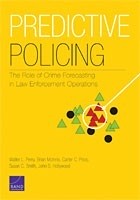| 来源类型 | Research Reports
|
| 规范类型 | 报告
|
| DOI | https://doi.org/10.7249/RR233
|
| ISBN | 9780833081483
|
| 来源ID | RR-233-NIJ
|
| Predictive Policing: The Role of Crime Forecasting in Law Enforcement Operations |
| Walter L. Perry; Brian McInnis; Carter C. Price; Susan Smith; John S. Hollywood
|
| 发表日期 | 2013
|
| 出版年 | 2013
|
| 页码 | 186
|
| 语种 | 英语
|
| 结论 |
There Are Four Primary Categories of Predictive Policing Methods; Each Includes Options to Suit the Capabilities and Requirements of Different Police Departments- Predictive policing methods fall into four general categories: methods for predicting crimes, methods for predicting offenders, methods for predicting perpetrators' identities, and methods for predicting victims of crime.
- Each category includes options for large departments that handle large amounts of complex data and for smaller departments that require only basic tools to manage and visualize small amounts of geospatial data. Available methods range from basic heuristic techniques to sophisticated, cutting-edge mathematical models.
Predictive Policing Methods Are Not Equivalent to a Crystal Ball, but They Can Enhance Proactive Policing and Improve Intervention Strategies- Predictive policing methods are not a crystal ball: they cannot foretell the future. They can only identify people and locations at increased risk of crime.
- The operational value of predictive policing tools is in their contribution to broader law enforcement strategies that use the tools' risk assessments to inform resource allocation and problem-solving decisions.
- The collection and use of data on individuals has raised a number of concerns about privacy rights and civil liberties. An understanding of the legal precedent, along with regular audits, public outreach strategies, and greater community involvement and buy-in, have helped police departments address these concerns.
|
| 摘要 |
- Predictive policing tools should be compatible with the data needs and capabilities of individual law enforcement agencies. Small agencies investigating few crimes are unlikely to need much more than core statistical and display capabilities. Larger agencies with large volumes of incident and intelligence data will want to consider more sophisticated systems. They may also want to consider how well the systems disseminate and display key supporting information on recent crime and disorder, intelligence, and policing activity, in addition to the predictions themselves, to better support decisionmaking at all levels.
- Developers should be aware of the major financial limitations that law enforcement agencies face in procuring and maintaining new systems, and they should avoid promising crystal ball–like capabilities when it comes to these systems.
- To be effective, predictive policing must include interventions based on analytical findings. Successful interventions typically have top-level support, sufficient resources, automated systems providing needed information, and assigned personnel with both the freedom to resolve crime problems and accountability for doing so.
- In all cases, law enforcement agencies should respect civil liberties and privacy rights. When implementing a predictive policing strategy, they should use good judgment in sharing information about possible offenders and victims, and they should work to involve and educate the community to address these concerns.
|
| 主题 | Crime
; Crime and Violence Prevention
; Cyber and Data Sciences
; Data Mining
; Databases and Data Collection
; Analysis
; and Processing
; Forecasting Methodology
; Geographic Information Systems
; Police-Community Relations
|
| URL | https://www.rand.org/pubs/research_reports/RR233.html
|
| 来源智库 | RAND Corporation (United States)
|
| 引用统计 |
|
| 资源类型 | 智库出版物
|
| 条目标识符 | http://119.78.100.153/handle/2XGU8XDN/107559
|
推荐引用方式
GB/T 7714 |
Walter L. Perry,Brian McInnis,Carter C. Price,et al. Predictive Policing: The Role of Crime Forecasting in Law Enforcement Operations. 2013.
|
|
文件名:
|
x1495294314229.jpg
|
|
格式:
|
JPEG
|

|
文件名:
|
RAND_RR233.pdf
|
|
格式:
|
Adobe PDF
|
除非特别说明,本系统中所有内容都受版权保护,并保留所有权利。